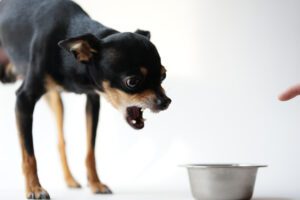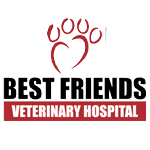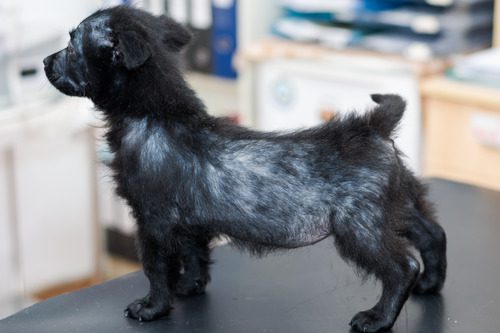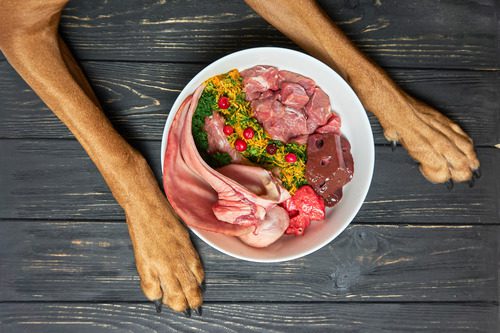Understanding Dog Food Aggression and How to Manage It
Dog food aggression, often known as resource guarding, can be concerning for pet owners. It involves a dog becoming belligerent towards anyone who tries to take its food or treats. This behavior can escalate and become dangerous for people and other animals around the dog. In this article, we will scout the reasons behind dog food aggression and provide some tips on how to manage it.
Reasons Behind Dog Food Aggression
There are several reasons your dog could be showing signs of food aggression.
Genetics
Some canine breeds are more prone to resource-guarding behavior than others. For example, the Cane Corso and the Akita are known to be more territorial and protective of their resources, including food. While genetics can play a role in a dog’s behavior, it is essential to remember that it is not the sole element.
Early Life Experiences
Dogs that have been famished or had to contend with other dogs for food in the past are more likely to inclined or develop food aggression behavior. Furthermore, dogs that have been rescued from negligent or offensive situations are prone to guard their food as a survival mechanism. Early life experiences can shape a dog’s behavior, but with proper training and consistency, this behavior can be managed.
Anxiety and Stress
Anxiousness and strain can also influence food aggression in dogs. For example, if a dog is anxious or stressed about its food supply, it may become territorial and hostile toward anyone who tries to take its food away.
Lack of Proper Training
If a dog has never been taught to share its food or treats, it may become possessive and aggressive when someone tries to take them away. Appropriate training and socialization are necessary for managing resource guarding.
Signs of Dog Food Aggression
It’s important to note that not all dogs display the same signs of food aggression. Some may show more subtle signs, such as avoiding eye contact or lowering their head while eating. Early intervention can help manage food aggression and prevent it from escalating into a more severe problem.
Growling or Snapping
Growling or snapping at people or other animals when they approach the dog while it’s eating or near its food.
Stiff Body Language
A stiff, tense body language while eating or when someone approaches its food.
Lunging
Lunging at people or other animals who get too close to its food.
Showing Teeth
Showing teeth, including baring its teeth, when someone approaches its food.
Eating Quickly
Eating its food quickly or frantically to prevent others from approaching it.
Possessive Behavior
Becoming possessive over its food or treats, and not allowing anyone to approach it.
Aggression Towards Other Dogs
Aggressively guarding food against other dogs or becoming aggressive towards other dogs when they try to eat or approach its food.
Refusing to Share
Refusing to share food or treats with people or other animals.

Managing Dog Food Aggression
The good news is that food aggression can be managed with proper training and consistency. Here are some tips on how to manage this behavior:
Seek Professional Help
If your dog’s food aggression is extreme, it is best to seek expert assistance. A certified dog trainer or behaviorist can evaluate your dog’s behavior and provide tailored advice on how to manage it. They may also assist you in figuring out any underlying problems that may be contributing to the aggression.
Avoid Punishing Your Dog
Scolding your dog for food aggression can make the behavior worse. Instead, emphasize positive reinforcement training. Reward your dog for good behavior and gradually increase the time you spend around its food bowl. Never take away your dog’s food bowl as punishment.
Teach Your Dog to Share
Teaching your dog to share its food and treats is essential in managing food aggression. Start by training your dog to sit and wait before giving it food. Gradually increase the time between the sit command and the food delivery. This will help your dog learn to wait patiently for its food.
Use Puzzle Feeders
Using puzzle feeders or slow feeders can help reduce food aggression in dogs. These feeders make it more challenging for dogs to eat quickly, which can reduce anxiety and aggression. Additionally, they can provide mental stimulation for your dog, which is essential for its overall well-being.
Feed Your Dog in a Safe Space
Create a safe space for your dog to eat its meals without feeling threatened. This can be a separate room or a designated area in your home where your dog feels comfortable and secure.
Practice Desensitization
Desensitization involves exposing your dog to situations that trigger its food aggression in a controlled and gradual manner. Start by having someone approach your dog while it’s eating and offering a high value treat. Repeat this several times, gradually getting closer to your dog until you can take the food away without any aggression.
Establish Boundaries
Teach your dog to respect boundaries when it comes to food. You can do this by setting rules around mealtimes and treats and reinforcing them consistently.
Socialize Your Dog
Proper socialization can help reduce anxiety and stress in dogs, which can contribute to food aggression. Expose your dog to different people, dogs, and environments to help it become more comfortable and confident.
Establish a routine
Dogs thrive on routine, and establishing a regular feeding schedule can help reduce anxiety and uncertainty around mealtime.
Teach the “leave it” command
This command can be used to communicate the dog to back away from its food bowl when prompted, which can help lower food aggression over time.
Monitor Your Dog’s Behavior
Pay attention to your dog’s behavior during mealtimes and treats. If you notice any signs of aggression, stop the interaction, and try again later.
Be Patient and Consistent
Managing dog food aggression takes time, patience, and consistency. Stick to a training plan and be patient with your dog as it learns to overcome this behavior.
Conclusion
Dog food aggression is a common issue that can be caused by a variety of factors. While it can be dangerous if left unaddressed, it is possible to manage this behavior through a combination of changes to the dog’s environment, training, and positive reinforcement. By identifying the underlying cause of the aggression and working with a professional as needed, it is possible to help your dog feel safe and secure during mealtime and reduce the risk of harm to themselves or others.
If your dog is showing signs of dog food aggression, contact Best Friends Veterinary Hospital. Our veterinarians can assess your pet’s behavior and help to come up with solutions. Call us today for more information.
Recent Posts
About Best Friends Veterinary Hospital
Our veterinarians and staff warmly welcome dogs, cats, and a variety of exotic pets as patients here at our animal hospital, and we offer a host of services to give your unique family member a lifetime of excellent care.





